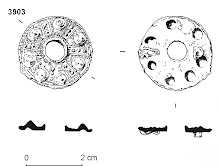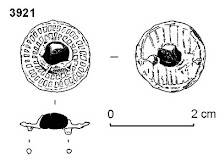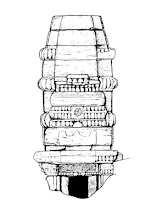The excavation work at LP Archaeology's 100 Minories site finished a
few weeks ago, but after a well-earned holiday work has re-started on
the post-excavation program. The first step is to finish checking the
3000 individual context records, making sure that they are all complete
and cross-referenced, both on the paper records and in the digital Ark
database. In addition thousands of hand-drawn plans and sections must be
checked; they will then be digitised using Q-GIS software
plug-ins developed during the excavation by LP Archaeology. The
digitised plans will then be loaded into the Ark database; this holds
scanned copies of the paper context sheets, as well as digital registers
for contexts, plans, sections, photographs and samples, and all the
digital photographs of the site. These are all cross-referenced and are
linked to the spatial plan data making a very powerful tool for
interrogating the site records.
A key component of the post-excavation work is the creation of a checked Harris Matrix. The Harris Matrix is a graphical representation of the stratigraphic sequence of the individual archaeological events (contexts) that make up the site sequence. It can be considered as a complex flowchart setting out the development of the site from natural geology to the modern overburden. The stratigraphic relationships between contexts are also loaded into the Ark database, enabling the stratigraphic sequence to be followed through the database. The matrix also forms a stratigraphic 'skeleton' to which the finds and environmental data will be related, and will form the basis of the written site sequence which will describe the chronological development of the site.
Meanwhile work continues on processing the thousands of finds -pottery, clay pipes, bricks, timbers, metalwork, glass, slag and animal bones and much more- and sending these off to specialists for an initial assessment. The hundreds of environmental samples will also be processed and the residues assessed and all this data will be added to the Ark database.
As work continues more discoveries will be made, and we'll continue to share those both here and on the 100 Minories website http://100minories.lparchaeology.com/
A key component of the post-excavation work is the creation of a checked Harris Matrix. The Harris Matrix is a graphical representation of the stratigraphic sequence of the individual archaeological events (contexts) that make up the site sequence. It can be considered as a complex flowchart setting out the development of the site from natural geology to the modern overburden. The stratigraphic relationships between contexts are also loaded into the Ark database, enabling the stratigraphic sequence to be followed through the database. The matrix also forms a stratigraphic 'skeleton' to which the finds and environmental data will be related, and will form the basis of the written site sequence which will describe the chronological development of the site.
Meanwhile work continues on processing the thousands of finds -pottery, clay pipes, bricks, timbers, metalwork, glass, slag and animal bones and much more- and sending these off to specialists for an initial assessment. The hundreds of environmental samples will also be processed and the residues assessed and all this data will be added to the Ark database.
As work continues more discoveries will be made, and we'll continue to share those both here and on the 100 Minories website http://100minories.lparchaeology.com/














No comments:
Post a Comment